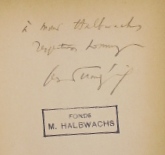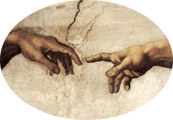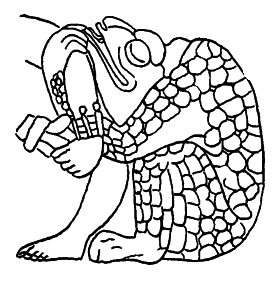モーリス・アルヴァックス
Maurice Halbwachs, 1877-1945
モーリス・アルヴァックス
Maurice Halbwachs, 1877-1945
"Maurice Halbwachs (French: [mɔˈʁis ˈalbvaks]; 11 March 1877 – 16 March 1945) was a French philosopher and sociologist known for developing the concept of collective memory. Halbwachs also contributed to the sociology of knowledge with his La Topographie Legendaire des Evangiles en Terre Sainte; study of the spatial infrastructure of the New Testament. (1951)" - Wiki)
モーリス・アルヴァックス(フランス語発音: [mɔʁis albvaks]、1877年3月11日 - 1945年3月16日)は、集団的記憶の概念を確立したことで知られるフランスの哲学者・社会学者である。アルヴァックスはまた、新約聖書の空間的基盤を 研究した『聖地における福音書の伝説的地形学』(1951年)によって、知識社会学にも貢献した。
| Maurice Halbwachs
(French: [mɔʁis albvaks]; 11 March 1877 – 16 March 1945) was a French
philosopher and sociologist known for developing the concept of
collective memory. Halbwachs also contributed to the sociology of
knowledge with his La Topographie Legendaire des Évangiles en Terre
Sainte, a study of the spatial infrastructure of the New Testament
(1951).[1][2] |
モーリス・アルヴァックス(フランス語発音: [mɔʁis albvaks]、1877年3月11日 - 1945年3月16日)は、集団的記憶の概念を確立したことで知られるフランスの哲学者・社会学者である。アルヴァックスはまた、新約聖書の空間的基盤を 研究した『聖地における福音書の伝説的地形学』(1951年)によって、知識社会学にも貢献した。[1][2] |
Early life and education Book signed by Georges Dumézil and offered to Maurice Halbwachs in the Human and Social Sciences Library Paris Descartes-CNRS, Maurice Halbwachs Collection. Born in Reims, France, Halbwachs attended the École Normale Supérieure in Paris. There he studied philosophy with Henri Bergson, who had a major influence on his thinking. Halbwachs' early work on memory was in some measure pursued to coincide with Bergson's view on the subject of memory being a particularly personal and subjective experience.[2] Bergson taught Halbwachs for three years.[3] He then aggregated in Philosophy in 1901. He taught at various lycées before traveling to Germany in 1904, where he studied at the University of Göttingen and worked on cataloging Leibniz's papers until 1907. He was nominated to co-edit an edition of Leibniz's work which never came to fruition. He returned to France in 1905 and met Émile Durkheim, who sparked his interest in sociology. Initially, when meeting Durkheim, Halbwachs was looking for advice on how to move from his previous focus on Philosophy to Sociology. Halbwachs also began to focus on scientific objectivism rather than his Bergsonian Individualism.[1] He soon joined the editorial board of L'Année Sociologique, where he worked with François Simiand and Lévy-Bruhl editing the Economics and Statistics sections. In 1909 he returned to Germany to study Marxism and economics in Berlin. Durkheim gave Halbwachs the idea of societal movements and how the environment, people are influenced by Sociological research. This also goes into how different class systems function in broad networks of society.[4] |
幼少期と学歴 ジョルジュ・デュメジルの署名入り書籍。モーリス・アルヴァックスに献呈されたもの。パリ・デカルト大学附属人文社会科学図書館(CNRS)所蔵、モーリ ス・アルヴァックス・コレクション。 フランス・ランス生まれのアルヴァックスは、パリの高等師範学校に学んだ。そこで彼はアンリ・ベルクソンに哲学を学び、その思想に大きな影響を受けた。ア ルヴァックスの記憶に関する初期の研究は、記憶が特に個人的で主観的な体験であるというベルクソンの見解と一致するよう、ある程度追求されたものである。 [2] ベルクソンはアルヴァックスに3年間教えた。[3] その後、アルヴァックスは1901年に哲学の国家資格試験に合格した。様々な高校で教鞭を執った後、1904年にドイツに渡り、ゲッティンゲン大学で学 び、1907年までライプニッツの論文目録作成に携わった。ライプニッツ著作の共編者として指名されたが、この計画は実現しなかった。 1905年にフランスへ帰国し、エミール・デュルケームと出会う。これが彼の社会学への関心を喚起した。当初アルヴァックスは、哲学から社会学へ転向する 方法についてデュルケームに助言を求めていた。また彼は、ベルクソン的な個人主義から科学的客観主義へと関心を移し始めた。[1] 間もなく『社会学年報』の編集委員会に加わり、フランソワ・シミアンやレヴィ=ブリュールと共に経済学と統計学の分野を編集した。1909年にはマルクス 主義と経済学を学ぶためベルリンへ渡独した。デュルケームはアルヴァックスに社会運動の概念と、環境や人民が社会学的研究によっていかに影響を受けるかを 示した。これはまた、異なる階級制度が社会の広範なネットワークの中でどのように機能するかという点にも及んでいる。[4] |
| Career Throughout World War I, Halbwachs worked at the War Ministry. Beginning in 1919,[5] shortly after the end of the war, he became professor of sociology and pedagogy at the University of Strasbourg (1919). He remained in this position for over a decade, taking leave for a year in 1930 as a visiting professor at the University of Chicago, when he was called to the Sorbonne in 1935. There he taught sociology and worked closely with Marcel Mauss and served as the editor of Annales de Sociologie, the successor journal to L'Année Sociologique. He taught as a professor of sociology in Sorbonne, Paris from 1935 to 1943 and a professor of social psychology at the College de France from 1943 until death. From 1935 until his death he also served as the secretary-general of Annales de Sociologie. In 1944 he received one of France's highest honors, a chair at the Collège de France in Social Psychology. During this time, Halbwachs dedicated his time to in-depth research in the field where sociology and psychology overlap to provide a bit of a timeline.[5] Towards the end of his life, Halbwachs was recognized for his contributions to sociology. He was elected into the Conservative Académie des Sciences Morales et Politiques. He was also recognized as the Vice President of the French Psychological Society, while also being called to chair at Sorbonne.[1] |
経歴 第一次世界大戦中、アルヴァックスは陸軍省で働いた。1919年[5]、戦争終結直後にストラスブール大学で社会学・教育学の教授に就任した(1919 年)。この職に10年以上留まり、1930年にはシカゴ大学の客員教授として1年間の休職を取った。1935年にはソルボンヌ大学に招かれ、そこで社会学 を教え、マルセル・モースと緊密に協力し、『社会学年報』の後継誌である『社会学年報』の編集長を務めた。1935年から1943年までパリ・ソルボンヌ 大学で社会学教授を務め、1943年から死去するまでコレージュ・ド・フランスで社会心理学教授を務めた。1935年から死去するまで『社会学年報』の事 務局長も兼任した。1944年にはフランス最高の栄誉の一つであるコレージュ・ド・フランス社会心理学講座の教授職を授与された。この時期、アルヴァック スは社会学と心理学が重なる領域における深い研究に時間を捧げた。彼の生涯の終わりに近づくと、アルヴァックスは社会学への貢献が認められた。保守的な道 徳政治科学アカデミーの会員に選出された。また、フランス心理学会の副会長として認められると同時に、ソルボンヌ大学の教授職に招かれたのである。 |
| Personal life and death He was married to Yvonne Basch, who introduced Halbwachs to her father, the president of the League for the Defense Human Rights and also influenced him to join the Jewish religion (he was born Catholic).[6] He had a son, Pierre Halbwachs, who influenced Deleuzian theory in the 1940s. A longtime socialist, Halbwachs and his sons were detained by the Gestapo in Paris in July, 1944[5] after protesting the arrest of his Jewish father-in-law.[7] He and his youngest son Pierre were deported to the concentration camp[5] Buchenwald. He died of dysentery in March[5] 1945.[8] In 1940, Halbwachs' brother in-law, Georges Basch committed suicide. His parents in-law Victor and Mme Basch aged 84 years old at the time were murdered by Germans.[5] Part of his books were offered by his widow to the library of the Centre d'études sociologiques and are now held at the Human and Social Sciences Library Paris Descartes-CNRS. In 1950, his work on collective memory was published posthumously by his daughter.[9] |
個人的な生活と死 彼はイヴォンヌ・バッシュと結婚した。彼女はアルヴァックスを、人権擁護連盟の会長である父親に紹介し、また彼がユダヤ教に改宗するよう影響を与えた(彼 はカトリック教徒として生まれた)。[6] 彼には息子ピエール・アルヴァックスがおり、1940年代にドゥルーズ理論に影響を与えた。 長年の社会主義者であったアルヴァックスとその息子たちは、1944年7月、ユダヤ人の義父の逮捕に抗議した後、パリでゲシュタポに拘束された[5]。彼 と末息子のピエールは強制収容所[5]ブーヘンヴァルトへ送還された。彼は1945年3月[5]、赤痢により死亡した。[8] 1940年、アルヴァックスの義理の兄弟であるジョルジュ・バッシュは自殺した。当時84歳だった義父母のヴィクトル・バッシュとマダム・バッシュはドイ ツ軍によって殺害された。[5] 彼の著書の一部は未亡人によって社会学研究センター図書館に寄贈され、現在はパリ・デカルト大学CNRS人文社会科学図書館に所蔵されている。 1950年、彼の集団記憶に関する著作は娘によって遺作として出版された。[9] |
| Main ideas Halbwachs' most important contribution to the field of sociology appeared in his posthumous book La Mémoire collective, 1950 ("The Collective Memory"), in which he advanced the thesis that a society can have a collective memory and that this memory is dependent upon the "cadre" or framework within which a group is situated in society. Thus, there is not only an individual memory but also a group memory that exists outside of and lives beyond the individual. An individual's understanding of the past is strongly linked to this group consciousness because every person can contribute a different memory or perspective to the collective group memory. Group memory is also different for every group that experiences a certain event, therefore "every group has its own collective memory and that collective memory differs from the collective memory of other groups.[10] This idea of memory being pursued proves people's expression of commemoration in our culture. Commemoration offers collective memory ties to society and its conceptions where physical monuments and rituals fix and affirm collectivity.[2][need quotation to verify] Halbwachs' Collective Memory includes two laws governing how this form of memory will evolve: a Law of Fragmentation, and a Law of Concentration.[11] Halbwachs also wrote an important book on suicide, Les Causes du suicide, 1930 ("The Causes of Suicide"). In this book he followed in the footsteps of his mentor Émile Durkheim (also a French sociologist), expanding and elaborating upon the Durkheim's theories on suicide. Specifically, he focused on ideas such as, the ways in which rural and urban styles of life explain variations in suicide rates. Halbwachs also continued to further Durkheim's conceptualization of how specific family styles and religious backgrounds alter rates of suicide.[1] Halbwachs included in his Les Cadres Sociaux de la Memoire (1952) the significance of the collective memory operating on the systems of family, religion and social communities.[2] Halbwachs takes an interesting perspective regarding the relationship between memory and history. He believed that memory and history oppose each other when it comes to reliability. Memory can be transformed based on perspective, which makes it a questionable form of scholarly appreciation for the past, whereas historians attempt to analyze history from a completely unbiased perspective, analyzing it in a critical way from a distance.[2] Halbwachs contributed to the world of social psychology as well with his thesis on La Classe ouvrière et les niveaux de vie, which translates to "The Working Class and the Standards of Living".[5] This work allowed Halbwachs to analyze and observe how working-class families managed their budgets. He discovered that families and individuals not only plan out their budget for what they need in the moment but what they also need in the future, which forces them to put into perspective what is necessary in the moment. His research is a modification of Durkheim's theory of collective representations.[5] |
主な考え方 アルヴァックスが社会学分野に最も重要な貢献をしたのは、死後出版された『集団的記憶』(1950年)においてである。彼はこの著作で、社会には集団的記 憶が存在し得るという主張を展開した。そしてこの記憶は、集団が社会の中で置かれている「枠組み」に依存していると論じた。したがって、個人の記憶だけで なく、個人を超え、個人の外に存在し、個人を超えて存続する集団の記憶も存在する。個人の過去に対する理解は、この集団意識と強く結びついている。なぜな ら、あらゆる人格が異なる記憶や視点を集団的記憶に寄与し得るからだ。また、特定の出来事を経験した集団ごとに集団記憶は異なる。したがって「あらゆる集 団は独自の集団記憶を持ち、その集団記憶は他の集団の集団記憶とは異なる」のである。[10] この記憶の追求という概念は、我々の文化における人民の追悼表現を証明している。追悼は社会とその概念への集団的記憶の絆を提供し、物理的な記念碑や儀礼 が集団性を固定し確認する。[2][出典が必要] アルヴァックスの『集団的記憶』には、この記憶形態がどのように進化するかを規定する二つの法則が含まれている:断片化の法則と集中化の法則である。 [11] アルヴァックスは自殺に関する重要な著作『自殺の原因』(1930年)も著した。この書では師であるエミール・デュルケーム(同じくフランス人社会学者) の足跡を辿り、デュルケームの自殺理論を拡張・深化させた。具体的には、農村と都市の生活様式が自殺率の差異を説明する点などに焦点を当てた。また、特定 の家族形態や宗教的背景が自殺率に与える影響について、デュルケームの概念化をさらに推し進めたのである。[1] アルヴァックスは『記憶の社会的枠組み』(1952年)において、家族・宗教・社会共同体というシステム上で機能する集団的記憶の重要性を論じている。 [2] アルヴァックスは記憶と歴史の関係について興味深い見解を示す。彼は信頼性という点で記憶と歴史は対立すると考えた。記憶は視点によって変容し得るため、 過去を学術的に評価する手段としては疑わしい。一方、歴史家は完全に偏りのない視点から歴史を分析しようと試み、距離を置いて批判的に考察するのだ。 [2] アルヴァックスは『労働者階級と生活水準』という論文でも社会心理学の世界に貢献した。[5] この研究によりアルヴァックスは、労働者階級の家庭が家計をどのように管理しているかを分析・観察した。彼は、家庭や個人が当面の必要性だけでなく将来の 必要性にも基づいて予算を計画していることを発見した。これは彼らが当面の必要性を相対化することを強いる。彼の研究はデュルケームの集合表象理論を修正 したものである。[5] |
| Influence and legacy Halbwachs showed how memory can not exist without society influencing the mind, embracing how collective consciousness impacts us each and every day. This taught us that social structure shapes the way we think an act on the world. He also establishes the difference between memory which is subjective and history is factual in its background.[12] |
影響と遺産 アルヴァックスは、記憶が社会の影響なしに存在し得ないことを示した。集団的意識が日々私たちに与える影響を包含しつつ、社会構造が私たちの思考や行動様 式を形作ることを教えたのである。また彼は、主観的な記憶と、背景において事実に基づく歴史との差異を確立した。[12] |
| Inspirations Halbwachs was influenced by ideas of Emile Durkheim, such as collective consciousness, with adding more to this term by individual and collective memory. Halbwachs was also influenced by Henri Bergson's stance on subjectivity, which creates states how this impacts our consciousness and intuition.[13] |
インスピレーション アルヴァックスはエミール・デュルケームの集団的意識といった思想に影響を受けた。彼はこの概念に個人記憶と集団記憶という要素を加えたのである。 アルヴァックスはまたアンリ・ベルクソンの主体性に関する立場にも影響を受けた。この立場は、主体性が我々の意識と直感にどのように影響するかを説明する ものである。[13] |
| Published works Halbwachs, Maurice, On collective memory, Chicago, The University of Chicago Press, 1992 translated from: Les cadres sociaux de la mémoire, Paris, Presses Universitaires de France, 1952, originally published in Les Travaux de L'Année Sociologique, Paris, F. Alcan, 1925 edited, translated and introduction by Lewis A. Coser, includes a translation of the conclusion of: La Topographie légendaire des évangiles en terre sainte: étude de mémoire collective, Paris, Presses Universitaires de France, 1941 Halbwachs, Maurice, The collective memory, New York, Harper & Row Colophon Books, 1980, 182 pages pdfs of chapters 1 and 2 available (pp. 22–49 and 50–87) on UCSB Collective Memory seminar website translated from: La mémoire collective, Paris, Presses Universitaires de France, 1950 Complete synthesis on all of his observations of memory Published after his death introduction by Mary Douglas, includes a translation of: ‘La mémoire collective chez les musiciens’, Revue philosophique, no. 3 – 4 (1939) Halbwachs, Maurice, La topographie légendaire des évangiles en Terre sainte, 1941 Reprinted in 2017, can be found on Amazon (ISBN 978-2130788973) Studies how memory is changed over a period of time in a single-setting Complete synthesis on all of his observations of memory Published after his death Halbwachs, Maurice, The Psychology of Social Class, London, Forgotten Books, 2017 Reprinted Classic available on Amazon in both hard and paperback copies (ISBN 9-78028-290759-4) Halbwachs, Maurice, Les causes du suicide, Paris, Presses Universitaires de France, 1930 |
刊行物 アルヴァックス、モーリス『集団的記憶について』シカゴ、シカゴ大学出版局、1992年 原著:Les cadres sociaux de la mémoire(パリ、プレス・ユニヴェルシテール・ド・フランス、1952年)、初出:Les Travaux de L'Année Sociologique(パリ、F. アルカン、1925年) ルイス・A・コザーによる編集・翻訳・序文付き。付録として以下の著作の結論部分の翻訳を含む:『聖地における福音書の伝説的地形学:集団的記憶の研究』 パリ、プレス・ユニヴェルシテール・ド・フランス、1941年 アルヴァックス、モーリス『集合的記憶』ニューヨーク、ハーパー&ロウ・コロフォンブックス、1980年、182ページ 第1章と第2章のPDF(pp.22-49および50-87)はUCSB集合的記憶セミナーウェブサイトで入手可能 原著:『集合的記憶』パリ、プレス・ユニヴェルシテール・ド・フランス、1950年 記憶に関する全観察の完全な統合 死後出版 メアリー・ダグラスの序文付き。翻訳収録:『音楽家における集団的記憶』哲学評論第3-4号(1939年) アルヴァックス、モーリス『聖地における福音書の伝説的トポグラフィー』1941年 2017年再版、Amazonで入手可能(ISBN 978-2130788973) 単一環境における記憶の時間的変容を研究 記憶に関する全観察の総合的考察 死後刊行 アルヴァックス、モーリス『社会階級の心理学』、ロンドン、Forgotten Books、2017年 復刻版。アマゾンでハードカバーとペーパーバックの両方入手可能(ISBN 9-78028-290759-4) アルヴァックス、モーリス『自殺の原因』、パリ、プレス・ユニヴェルシテール・ド・フランス、1930年 |
| Further reading Michel Verret, Lectures sociologiques: Bourdieu, Passeron, Hoggart, Halbwachs, Janet, Le Play, Girard, Naville, Paris, Harmattan, 2009 (ISBN 978-2-296-10391-7). Dietmar Wetzel, Maurice Halbwachs, Konstanz, UVK Verlagsgesellschaft, 2009 (ISBN 978-3-86764-106-7). Marie Jaisson and Christian Baudelot, eds, Maurice Halbwachs, sociologue retrouvé, Paris, Rue d’Ulm, 2007 (ISBN 978-2-7288-0387-3). Annette Becker, Maurice Halbwachs, un intellectuel en guerres mondiales 1914-1945, Paris. Agnès Viénot, 2003 (ISBN 2-914645-46-5). Gérard Namer, Halbwachs et la mémoire sociale, Paris, L’Harmattan, 2000 (ISBN 2-7384-9595-8). Marra, Realino (1988). "Halbwachs, la memoria collectiva e lo spazio giuridico (Halbwachs, la mémoire collective et l'espace juridique)". Sociologia del Diritto. 15 (1): 141–150. INIST 12017840. Russell, Nicolas (2006). "Collective Memory before and after Halbwachs". The French Review. 79 (4): 792–804. JSTOR 25480359. Hirsch, Thomas; Hamilton, Peter (2016). "A Posthumous Life: Maurice Halbwachs and French Sociology (1945–2015)". Revue française de sociologie. 57 (1): 48–71. doi:10.3917/rfs.571.0071. JSTOR 26567186. |
追加文献(さらに読む) ミシェル・ヴェレ『社会学講義:ブルデュー、パセロン、ホガート、アルヴァックス、ジャネ、ル・プレイ、ジラール、ナヴィル』パリ、アルマタン社、 2009年(ISBN 978-2-296-10391-7)。 ディートマー・ヴェッツェル著『モーリス・アルヴァックス』コンスタンツ、UVK出版、2009年(ISBN 978-3-86764-106-7) マリー・ジャソン、クリスチャン・ボードロ編『モーリス・アルヴァックス、再発見された社会学者』パリ、リュ・ドゥルム、2007年(ISBN 978-2-7288-0387-3)。 アネット・ベッカー『モーリス・アルヴァックス、世界大戦下の知識人 1914-1945』パリ。アニュズ・ヴィエノ、2003年(ISBN 2-914645-46-5)。 ジェラール・ナメル、『アルヴァックスと社会的記憶』、パリ、ラルマタン社、2000年(ISBN 2-7384-9595-8)。 マラ、レアリノ(1988)。「アルヴァックス、集合的記憶と法的空間(アルヴァックス、集合的記憶と法的空間)」。『法社会学』15巻1号: 141–150頁。INIST 12017840。 ラッセル、ニコラス (2006). 「アルヴァックス以前と以後の集合的記憶」. The French Review. 79 (4): 792–804. JSTOR 25480359. ヒルシュ、トーマス; ハミルトン、ピーター (2016). 「死後の生活:モーリス・アルヴァックスとフランス社会学(1945年~2015年)」。Revue française de sociologie(フランス社会学雑誌)。57 (1): 48–71. doi:10.3917/rfs.571.0071. JSTOR 26567186. |
| References 1. Coser, Lewis A. (1992). Maurice Halbwachs On Collective Memory. The University of Chicago Press. ISBN 0-226-11594-1. 2. Hutton, Patrick H. (1988). "Collective Memory and Collective Mentalities: The Halbwachs-Ariés Connection". Historical Reflections / Réflexions Historiques. 15 (2): 311–322. JSTOR 23232416. 3. "Maurice Halbwachs | Encyclopedia.com". www.encyclopedia.com. Retrieved 2021-10-19. 4. On Collective Memory. 5. Friedmann, Georges; Mueller, John H. (1946). "Maurice Halbwachs, 1877-1945". American Journal of Sociology. 51 (6): 509–517. doi:10.1086/219882. JSTOR 2770677. S2CID 144272350. 6. "Halbwachs, Maurice (1877–1945) | Encyclopedia.com". www.encyclopedia.com. Retrieved 2023-10-06. 7. Novick, Peter (1999). The Holocaust in American Life. New York: Mariner Books. p. 3. ISBN 978-0618082322. 8. Jorge Semprun: Schreiben oder Leben (Frankfurt: Suhrkamp, 1995), pp. 28 ff. 9. "Maurice Halbwachs - Buchenwald Memorial". 10. Russell, Nicolas (2006). "Collective Memory before and after Halbwachs". The French Review. 79 (4): 792–804. JSTOR 25480359. 11. Errll, Astrid (2008). Cultural Memory Studies - An International and Interdisciplinary Handbook. Walter de Gruyter. 12. Russell, Nicolas (2006). "Collective Memory before and after Halbwachs". The French Review. 79 (4): 792–804. ISSN 0016-111X. JSTOR 25480359. 13. "Maurice Halbwachs - an overview | ScienceDirect Topics". www.sciencedirect.com. Retrieved 2023-10-06. |
参考文献 1. コザー、ルイス・A. (1992). 『モーリス・アルヴァックスと集団的記憶』. シカゴ大学出版局. ISBN 0-226-11594-1. 2. ハットン、パトリック・H. (1988). 「集団的記憶と集団的メンタリティ:アルヴァックスとアリエの関連性」. 『歴史的考察/歴史的省察』. 15 (2): 311–322. JSTOR 23232416. 3. 「モーリス・アルヴァックス|Encyclopedia.com」www.encyclopedia.com. 2021年10月19日閲覧. 4. 『集団的記憶について』 5. フリードマン、ジョルジュ; ミューラー、ジョン・H. (1946). 「モーリス・アルヴァックス、1877-1945」。『アメリカ社会学雑誌』。51巻6号:509–517頁。doi:10.1086/219882。 JSTOR 2770677。S2CID 144272350。 6. 「アルヴァックス、モーリス(1877–1945)|Encyclopedia.com」. www.encyclopedia.com. 2023年10月6日閲覧. 7. ノヴィック、ピーター(1999年)。『アメリカ社会におけるホロコースト』. ニューヨーク:マリナー・ブックス. p. 3. ISBN 978-0618082322. 8. ホルヘ・センプルン『書くことか生きるか』(フランクフルト:スールカンプ、1995年)、28頁以降。 9. 「モーリス・アルヴァックス - ブッヘンヴァルト記念館」 10. ラッセル、ニコラス(2006年)。「アルヴァックス以前と以後の集団記憶」『ザ・フレンチ・レビュー』79巻4号: 792–804頁。JSTOR 25480359。 11. アストリッド・エルル(2008)。『文化記憶研究―国際的・学際的手引書』。ウォルター・デ・グリュイター社。 12. ニコラス・ラッセル(2006)。「アルヴァックス以前と以後の集団的記憶」『ザ・フレンチ・レビュー』79巻4号: 792–804頁。ISSN 0016-111X。JSTOR 25480359。 13. 「モーリス・アルヴァックス - 概要 | ScienceDirect トピックス」www.sciencedirect.com。2023年10月6日閲覧。 |
★年譜
1877 ランス生まれ。
n.d École Normale Supérieure in Paris修了 ベルクソン(Henri-Louis Bergson, 1859-1941)研究
1901 He aggregated in Philosophy
1904 He taught at various lycées before traveling to Germany in 1904, where he studied at the University of Göttingen and worked on cataloging Leibniz's papers. He was nominated to co-edit an edition of Leibniz's work which never came to fruition.
1905 He returned to France in 1905 and met Émile Durkheim, who sparked his interest in sociology. Initially, when first meeting Durkheim, Halbwachs was looking for advice on how to move from his previous focus on Philosophy to Sociology. Halbwachs also began to focus on scientific objectivism rather than his Bergsonian Individualism.
n.d He soon joined the editorial board of L'Année Sociologique, where he worked with François Simiand editing the Economics and Statistics sections. In 1909 he returned to Germany to study Marxism and economics in Berlin.
1913
『平均人の理論:ケトレおよび道徳統計学について』『労働者階級と生活水準』
1914-1918 Halbwachs
worked at the War Ministry.
1918? カーン大学文学部
1919 shortly after the
end of the war, he became professor of sociology and pedagogy at the University of Strasbourg(1919-1935).
1923 「数量的見地からみた人類」『アンシクロ
ペディア・フランセーズ』
1924 M・フレシェとの共著『万人向けの確率
論』
1925 Les cadres sociaux de la mémoire,
Paris, Presses Universitaires de France, 1952, originally published in
Les Travaux de L'Année Sociologique, Paris, F. Alcan, 1925(『記憶の社会的枠』)
1930
Halbwachs also wrote an
important book on suicide, Les Causes du suicide, 1930 ("The Causes of
Suicide"). In this book he followed the footsteps of his mentor Émile
Durkheim, expanding and elaborating upon the former's theories on
suicide. Specifically, he focused on ideas such as, the ways in which
rural and urban styles of life explain variations in suicide rates.
Halbwachs also continued to further Durkheim's conceptualization of how
specific family styles and religious backgrounds alter rates of
suicide.
a visiting professor at
the University of Chicago, 1930.
1932 道徳政治アカデミー通信会員、国際統計学
会会員
1935
He remained in this
position for over a decade, taking leave for a year as a visiting
professor at the University of Chicago, when he was called to the Sorbonne in 1935.
There he taught sociology and worked closely with Marcel Mauss and
served as the editor of Annales de Sociologie, the successor journal to
L'Année Sociologique.
1938 『社会形態学』。フランス社会学院
1939 ‘La mémoire
collective chez les musiciens’, Revue philosophique, no. 3 – 4 (1939)
1940
1940s He also had a son, Pierre Halbwachs [French literary critic], who influenced Deleuze in the 1940s.
1944
In 1944 he received one of France's highest honors, a chair at the Collège de France in Social Psychology. During this time, Halbwachs dedicated his time to in-depth research in the field where sociology and psychology overlap. A longtime socialist, Halbwachs was detained by the Gestapo in Paris in July, 1944[3] after protesting the arrest of his Jewish father-in-law.He was deported to the concentration camp,[3] Buchenwald, where he died of dysentery in February[3] 1945(※ミッシェル・アレクサンドルによると5月)
1945 Halbwachs' brother in-law, Georges Basch committed suicide. His parents in-law Victor and Mme Basch aged 84 years old at the time were murdered by Germans.
1950 La Mémoire collective, 1950, Paris
: Presses universitaires de France , 1950.
Halbwachs' most important contribution to the field of sociology came in his book La Mémoire collective, 1950 ("The Collective Memory"), in which he advanced the thesis that a society can have a collective memory and that this memory is dependent upon the "cadre" or framework within which a group is situated in a society. Thus, there is not only an individual memory, but also a group memory that exists outside of and lives beyond the individual. Consequently, an individual's understanding of the past is strongly linked to this group consciousness. This idea of memory Halbwachs pursued to prove through peoples expression of commemoration in our culture. Commemoration offers collective memory tie to society and its conceptions where physical monuments and rituals fix and affirm collectivity. Halbwachs Collective Memory includes two laws governing how this form of memory will evolve. The two laws are called a Law of Fragmentation, and a Law of Concentration.
1968 La Mémoire
Collective / Maurice Halbwachs ; préface de Jean Duvignaud ;
Introduction de J. Michel Alexandre, 2. éd. rev. et augm. - Paris :
Presses Universitaires de France , 1968.
1982 Halbwachs,
Maurice, The collective memory, New York, Harper & Row Colophon
Books, 1980, 182 pages
1992 Halbwachs,
Maurice, On collective memory, Chicago, The University of Chicago
Press, 1992
●『集合的記憶』
1.集合的記憶と個人的記憶
2.集合的記憶と歴史的記憶
3.集合的記憶と時間
4.集合的記憶と空間
附録:集合的記憶と音楽家
●'cause we're living in Newtonian duration time and I am Newtonian girl, cannot experience in Bergsonian duration. - An Introduction to Cybernetics, Ch.1

リンク
文献
その他の情報
Copyleft, CC, Mitzub'ixi Quq Chi'j, 1996-2099


++
Copyleft,
CC, Mitzub'ixi Quq Chi'j, 1996-2099